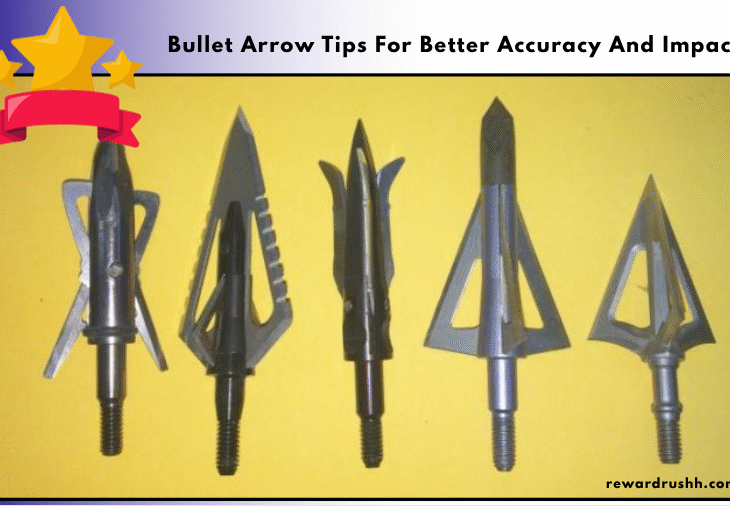Ever felt like your arrows are playing hide-and-seek with the bullseye? You’re not alone! Many archers struggle with consistent accuracy.
The secret weapon? Choosing the right bullet arrow tips for better accuracy and impact.
In this article, we’ll dive into the world of arrow tips, helping you understand how they affect your shot and how to pick the perfect ones to elevate your archery game. Get ready to hit your mark every time!
Understanding the Basics of Arrow Tips
Arrow tips, also known as points, are more than just pointy ends. They play a crucial role in arrow flight, penetration, and overall accuracy.
Let’s explore the different types and how they contribute to your success.
What are Bullet Arrow Tips?
Bullet arrow tips are characterized by their smooth, rounded shape. This design offers several advantages, making them a popular choice for target practice and hunting small game.
They are designed to be aerodynamic and durable. This helps ensure consistent performance.
Anatomy of an Arrow Tip
An arrow tip typically consists of a point, a shoulder, and a shank.
- Point: The very end that makes contact with the target.
- Shoulder: The wider section that transitions to the shaft.
- Shank: The part that inserts into the arrow shaft.
Understanding these components helps you appreciate how each part contributes to the arrow’s overall performance.
Types of Arrow Tips and Their Uses
The world of arrow tips is vast and varied. Each type is designed for specific purposes.
Let’s explore some common types.
Target Points
Target points are designed for, well, target practice! They are typically made of steel and feature a smooth, streamlined design.
Their primary goal is to minimize damage to targets while providing consistent accuracy.
Field Points
Field points are similar to target points but often have a slightly more rounded shape. This makes them suitable for both target practice and small game hunting.
They are versatile and affordable, making them a great choice for archers of all levels.
Broadheads
Broadheads are designed for hunting larger game. They feature sharp blades that create a larger wound channel for quicker, more humane kills.
These are typically heavier and more complex in design compared to target or field points.
Judo Points
Judo points are designed to prevent arrows from burying themselves in grass or leaves. They feature small wire arms that catch on vegetation.
These are perfect for practicing in areas where losing arrows is a concern.
How Bullet Arrow Tips Improve Accuracy
So, how do bullet arrow tips specifically contribute to better accuracy? Let’s break it down.
Aerodynamic Design
The smooth, rounded shape of bullet arrow tips minimizes air resistance. This results in a flatter trajectory and more consistent arrow flight.
Less drag means the arrow maintains its speed and direction more effectively.
Consistent Weight Distribution
Bullet arrow tips are typically manufactured to precise weight specifications. This ensures consistent weight distribution across all your arrows.
Consistent weight helps to eliminate variables that can affect accuracy.
Reduced Deflection
The streamlined design of bullet arrow tips reduces the likelihood of deflection upon impact. This is especially important when shooting at targets with varying densities.
Less deflection means your arrow is more likely to hit its intended mark.
Choosing the Right Bullet Arrow Tips
Selecting the right bullet arrow tips can feel overwhelming. Here are some factors to consider.
Arrow Spine
Arrow spine refers to the stiffness of the arrow shaft. It’s crucial to match your arrow tip weight to your arrow spine for optimal performance.
A heavier tip can cause a weak-spined arrow to flex excessively, while a lighter tip may not provide enough stability.
Arrow Weight
The overall weight of your arrow, including the tip, affects its speed and trajectory. Heavier arrows tend to be more stable and penetrate deeper.
However, they also have a more pronounced drop at longer distances.
Target Material
Consider the type of target you’ll be shooting at. Softer targets may require lighter tips, while harder targets may benefit from heavier, more durable tips.
Matching your tip to the target material will improve accuracy and prevent damage to your equipment.
Personal Preference
Ultimately, the best bullet arrow tips for you will depend on your personal shooting style and preferences. Experiment with different weights and designs to find what works best.
Don’t be afraid to try different options until you find the perfect fit.
Installation and Maintenance of Bullet Arrow Tips
Proper installation and maintenance are essential for ensuring the longevity and performance of your bullet arrow tips.
Installing Arrow Tips
Most bullet arrow tips are designed to screw into the threaded insert in the arrow shaft. Ensure the threads are clean and free of debris before installation.
Tighten the tip securely, but avoid over-tightening, which can damage the insert.
Cleaning and Inspection
Regularly clean your arrow tips with a soft cloth to remove dirt and debris. Inspect them for signs of damage, such as bent points or stripped threads.
Replace any damaged tips immediately to prevent accuracy issues and potential safety hazards.
Sharpening
While bullet arrow tips are not designed to be razor-sharp like broadheads, keeping them in good condition will improve their performance.
Use a fine file or sharpening stone to remove any burrs or imperfections from the point.
Tips for Improving Accuracy with Bullet Arrow Tips
Now that you’ve chosen and installed your bullet arrow tips, here are some tips to help you improve your accuracy.
Proper Stance and Grip
A stable stance and consistent grip are fundamental to accurate shooting. Ensure your feet are shoulder-width apart and your weight is evenly distributed.
Grip the bow lightly, avoiding excessive tension in your hand and arm.
Consistent Draw Length
Maintaining a consistent draw length is crucial for achieving consistent results. Use a draw check or anchor point to ensure you’re pulling the arrow back to the same spot every time.
Consistency in your draw length minimizes variations in arrow speed and trajectory.
Smooth Release
A smooth, controlled release is essential for minimizing disturbances to the arrow’s flight. Avoid jerking or slapping the string, as this can cause the arrow to veer off course.
Focus on releasing the string cleanly and allowing the bow to do its job.
Follow Through
After releasing the arrow, maintain your stance and follow through with your shot. This helps to stabilize the bow and prevent unwanted movement.
Visualize the arrow hitting its target and hold your position until it does.
The Impact of Arrow Weight on Accuracy
The weight of your arrow, including the bullet arrow tip, significantly impacts accuracy. Understanding this relationship is key to optimizing your setup.
Lighter Arrows
Lighter arrows tend to be faster and have a flatter trajectory. This can make them easier to aim at shorter distances.
However, they are also more susceptible to wind and other external factors.
Heavier Arrows
Heavier arrows are more stable and penetrate deeper. This makes them a better choice for hunting and shooting at longer distances.
They are less affected by wind but have a more pronounced drop, requiring more precise aiming.
Finding the Balance
The ideal arrow weight depends on your specific needs and preferences. Experiment with different weights to find the balance that works best for you.
Consider factors such as your draw weight, shooting distance, and target material.
Advanced Techniques for Fine-Tuning Accuracy
Once you’ve mastered the basics, you can explore advanced techniques to fine-tune your accuracy even further.
Bare Shaft Tuning
Bare shaft tuning involves shooting arrows without fletchings to diagnose and correct inconsistencies in your setup.
By observing how the bare shaft flies compared to fletched arrows, you can identify issues with arrow spine, nock point, and center shot.
Paper Tuning
Paper tuning involves shooting arrows through a sheet of paper to analyze their flight characteristics. The tears in the paper reveal whether the arrow is flying straight or if adjustments are needed.
This technique can help you fine-tune your rest and nock point for optimal accuracy.
Walk-Back Tuning
Walk-back tuning involves shooting arrows at a target from increasing distances. By observing the arrow’s impact points, you can identify and correct inconsistencies in your sight settings.
This technique is particularly useful for archers who shoot at varying distances.
Conclusion
Choosing the right bullet arrow tips for better accuracy and impact is a game-changer for any archer. Understanding the different types, how they affect arrow flight, and how to maintain them will significantly improve your shooting.
Experiment with different options, practice consistently, and fine-tune your technique to hit your mark every time. Now, what are your experiences with different arrow tips? Share your thoughts and tips below!
FAQ
What is the ideal weight for bullet arrow tips?
The ideal weight depends on your arrow spine, draw weight, and shooting style. Generally, a range of 70-125 grains is common for target and field points. Experiment to find what works best for you.
How often should I replace my bullet arrow tips?
Replace your bullet arrow tips whenever they show signs of damage, such as bent points or stripped threads. Regular inspection and maintenance will help extend their lifespan.
Can I use bullet arrow tips for hunting?
While bullet arrow tips are suitable for small game hunting, they are not recommended for larger game. Use broadheads designed for hunting to ensure a quick and humane kill.










